Considered a true jungle cacti, Epiphyllum has its natural roots in the tropical rain forests of Mexico. It happily lives among the treetops, living off other plants and getting all it needs to flourish. Orchid cacti are perfect for your patio or in a spot that gets indirect light.
In our guide, we’ve got a list of some of the popular Epiphyllum varieties and an easy guide on propagation. Learn how to offer the best care to your orchid cactus, as well as pests and diseases you might need to look out for.
More...
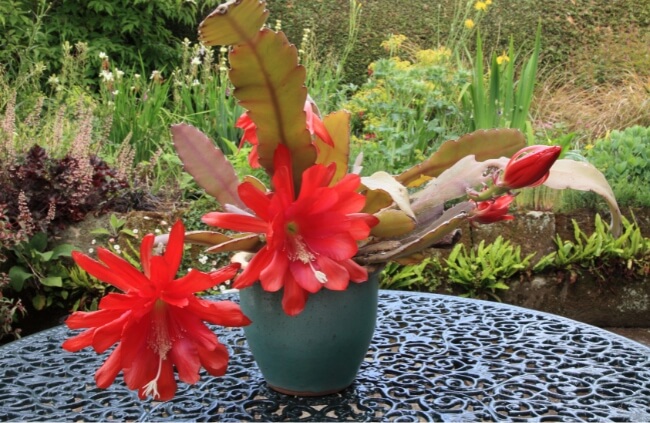
Family: | Cactaceae |
|---|---|
Genus: | Epiphyllum |
Species: | Various |
Origin: | South America and Central America |
Common Names: | Orchid cacti, climbing cacti, leaf cactus |
Location: | Outdoor |
Type: | Evergreen cactus |
Growth: | Up to 3 m tall and 90 cm spread |
Sun requirements: | Partial sun |
Foliage Colour: | Green |
Flower Colour: | Red, pink, white, cream, orange, yellow, purple |
Flowering: | Spring and summer |
Edible Parts: | Fruit |
Maintenance level: | Low |
Poisonous for pets: | Non-toxic to cats and dogs |
Introducing Epiphyllum
Epiphyllum or epiphytic cacti are treasured for their magnificent flowers. Orchid cacti look great in a hanging basket due to the way it grows with long luscious leaves.
Flowering usually happens from the end of winter to the end of summer, bringing with it a lovely fragrance. These are no ordinary flowers. They are impressive in size, with plenty of petals in shades from white to crimson.
Blooming only at night and fading by the time the sun comes up, it seems to have a bit of mystery. After the flowers come the fruit which tastes like passion fruit but has the texture of kiwi.
Epiphyllum Varieties
Epiphyllum oxypetalum - Dutchman's Pipe Cactus
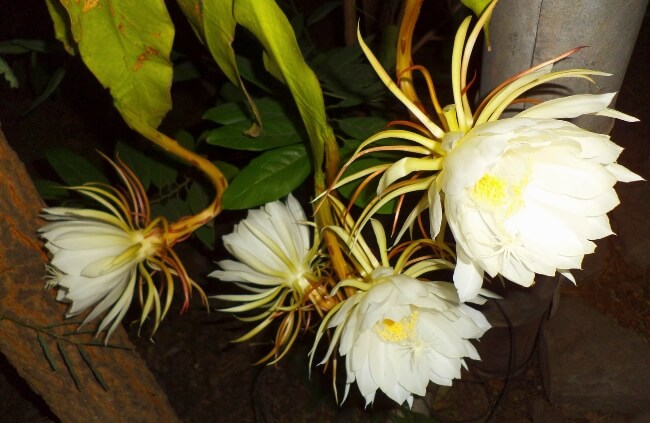
This is a fast growing variety and is probably one of the most cultivated. Often it’s able to produce a few flower displays in a single season. The flowers bloom at night and disappear before daylight.
These floral beauties are large, fragrant, with white inner petals and outer petals that are cream to pink in colour. Flowers of this variety are shaped like a funnel. This is why it’s also often called the Dutchman's pipe cactus. Other names include Princess of the Night or Queen of the Night.
Epiphyllum anguliger - Fishbone Cactus
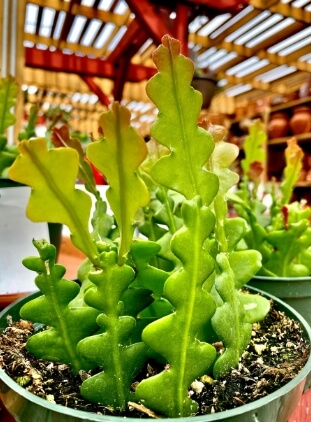
This variety is also known as the Fishbone cactus. The shape of the stems and leaves are what earned the plant its name. Spring and summer bring a display of white or yellow flowers.
Epiphyllum chrysocardium - Fern Leaf Cactus
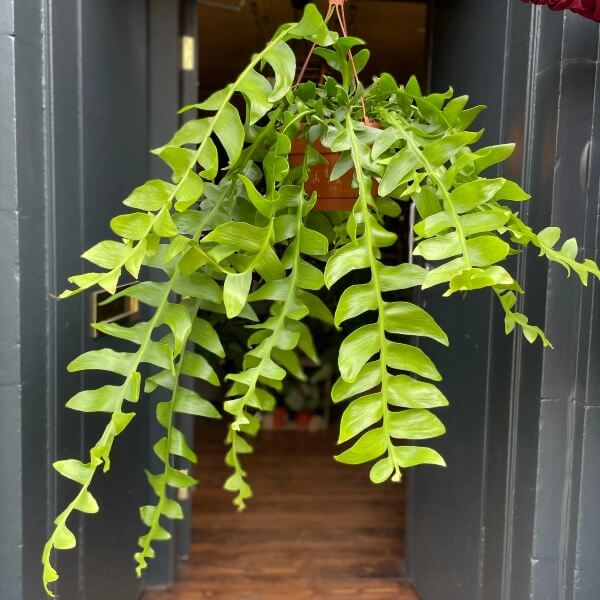
Source: grow urban.
This variety is often known as the Fern Leaf cactus, Golden Heart Epiphyllum, or the Shark Tooth cactus. It has long and narrow leaves that look similar to a fern, and the cactus rarely produces flowers.
When it does, the blooms have white inner petals and outer petals that are pink and white.
Epiphyllum guatemalense - Curly Locks Orchid Cactus
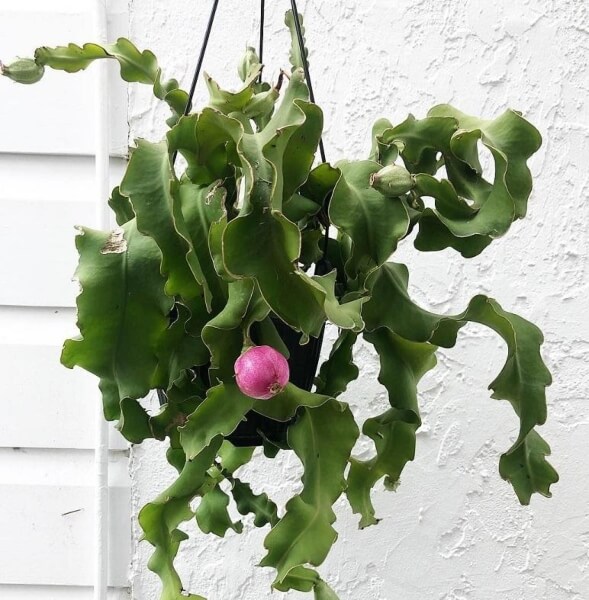
Source: Rare Plants
This variety is more popular for its unique leaves which are more appealing than the flowers. Other names include Curly Locks Epiphyllum or Curly Sue. The plant’s stems look a lot like strands of hair thanks to their wavy shape.
The white flowers bloom at night and are followed by pinkish fruit.


Get Your Free Guide:
Master Growing Australian Natives eBook
A Must Have Complete Guide for Every Australian Garden
Get Your Free Guide:
Master Growing Australian Natives eBook
A Must Have Complete Guide for Every Australian Garden
Epiphyllum hookeri - Hooker's Orchid Cactus

This variety produces big white flowers which either have no scent or otherwise a very slight fragrance. This orchid cactus blooms for one night only each year and this could be during spring, summer or autumn. The plant’s stems are wavy and can grow incredibly long.
Epiphyllum laui
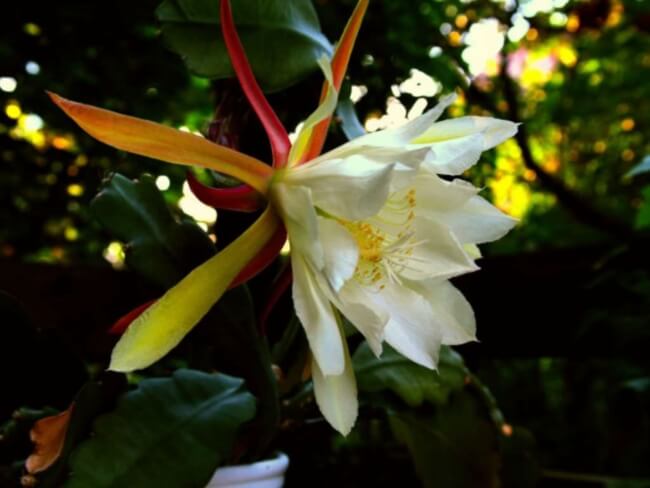
Source: World of Succulents
This variety has flowers shaped like funnels, with inner petals that are white and outer petals in a gold to brown colour. The blooms open at night and have a short lifespan, lasting around 2 days.
This orchid cactus is known for sometimes taking many years before it produces flowers. Overall the plant grows compactly with stems that are glossy with bits of red.
Epiphyllum phyllanthus - Climbing Cactus
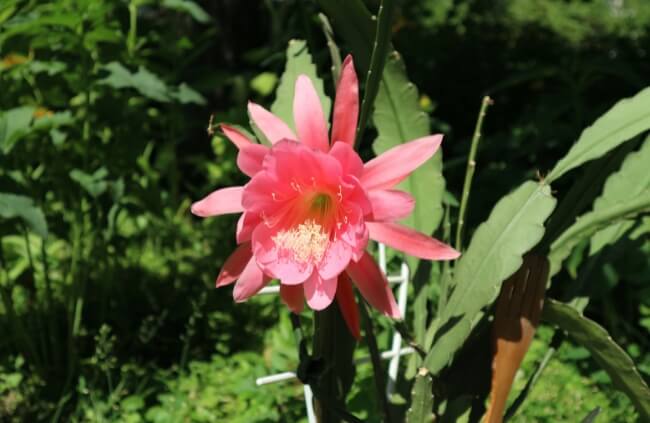
This variety is also called Climbing Cactus and produces small and fragrant white flowers that open at night. The outer petals of the blooms are a green white and the inner petals are creamy white.
The stems like to climb and branch out and are able to reach great lengths. Fruit produced by this orchid cactus is red or purple.
Epiphyllum oxypetalum - Dutchman's Pipe CactusThis is a fast growing variety and is probably one of the most cultivated. Often it’s able to produce a few flower displays in a single season. The flowers bloom at night and disappear before daylight. These floral beauties are large, fragrant, with white inner petals and outer petals that are cream to pink in colour. Flowers of this variety are shaped like a funnel. This is why it’s also often called the Dutchman's pipe cactus. Other names include Princess of the Night or Queen of the Night. |  |
Epiphyllum anguliger - Fishbone CactusThis variety is also known as the Fishbone cactus. The shape of the stems and leaves are what earned the plant its name. Spring and summer bring a display of white or yellow flowers. |  |
Epiphyllum chrysocardium - Fern Leaf CactusThis variety is often known as the Fern Leaf cactus, Golden Heart Epiphyllum, or the Shark Tooth cactus. It has long and narrow leaves that look similar to a fern, and the cactus rarely produces flowers. When it does, the blooms have white inner petals and outer petals that are pink and white. |  Source: grow urban. |
Epiphyllum guatemalense - Curly Locks Orchid CactusThis variety is more popular for its unique leaves which are more appealing than the flowers. Other names include Curly Locks Epiphyllum or Curly Sue. The plant’s stems look a lot like strands of hair thanks to their wavy shape. The white flowers bloom at night and are followed by pinkish fruit. |  Source: Rare Plants |
Epiphyllum hookeri - Hooker's Orchid CactusThis variety produces big white flowers which either have no scent or otherwise a very slight fragrance. This orchid cactus blooms for one night only each year and this could be during spring, summer or autumn. The plant’s stems are wavy and can grow incredibly long. |  |
Epiphyllum lauiThis variety has flowers shaped like funnels, with inner petals that are white and outer petals in a gold to brown colour. The blooms open at night and have a short lifespan, lasting around 2 days. This orchid cactus is known for sometimes taking many years before it produces flowers. Overall the plant grows compactly with stems that are glossy with bits of red. |  Source: World of Succulents |
Epiphyllum phyllanthus - Climbing CactusThis variety is also called Climbing Cactus and produces small and fragrant white flowers that open at night. The outer petals of the blooms are a green white and the inner petals are creamy white. The stems like to climb and branch out and are able to reach great lengths. Fruit produced by this orchid cactus is red or purple. |  |
How to Grow Epiphyllums in Australia
Ideal Conditions for Planting Epiphyllums
Where to Plant Your Orchid Cactus
Orchid cactus are delicate when it comes to sunlight. They don’t like to be in full sun for long periods of time so growing them in part shade is perfect. You could use a shade cloth if necessary depending which part of Australia you live in.
Living in partial sunlight mimics the type of light that orchid cacti experience in their natural growing habitat. A bit of morning sun is fine, but definitely protect your orchid cacti from the harsh midday sun.
Orchid cacti will let you know if they are experiencing sunburn. If you notice that the stems are turning red or yellow, it’s time to provide more shade for the plant. Since so many varieties exist, some may prefer more or less sunlight.
What Soil to Use
The most important consideration for this plant is to have a well-draining soil. You want to avoid water pooling around the roots otherwise you could end up with root rot. Make sure there is sufficient air circulation for the roots as well.
Propagating Epiphyllums
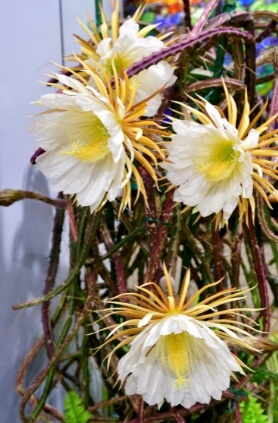
The easiest way to propagate epiphyllum is using cuttings. Aim for healthy sections from an existing plant and cut sections that are at least 23 cm in length. If the cuttings are too short, their time to flower might be longer.
Once you’ve taken your cuttings, you’ll need to wait for the cut to dry and harden completely. This takes around a week. Once this part of the process is complete, you can plant cuttings to a depth of around 5 cm in a well-draining potting mix.
Adding perlite is recommended. Place your cuttings somewhere warm and with partial light.
Initially, you can just mist the cuttings for their water needs. When the roots start forming, you can then begin watering and be sure to maintain a damp but not soggy potting mixture. A temperature around 21°C is ideal for the cuttings and they take between 4 to 6 weeks to root.
Caring for Orchid Cactus
If you want to keep your orchid cactus happy, there are a few things to bear in mind. A cool and shady spot that only gets morning sun and protection from extreme temperatures is important.
Find a watering schedule that ensures the plant doesn’t dry out and throw in some liquid fertiliser every 2 weeks when your plant is in its flowering phase. Since orchid cacti enjoy company, if they can grow through other plants or shrubs to offer some structural support, they will be happy.
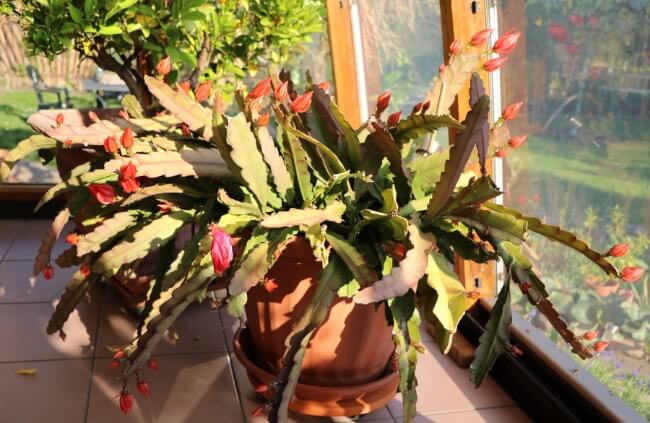
Watering Schedule
Probably the most important piece of advice when it comes to watering orchid cacti is not to overdo it. If growing in a pot, water until the excess flows out the drainage holes and then stop. When we think of cacti, we often think of minimal watering.
While this is usually true, this plant needs plenty of moisture while they are in the growing period. You can cut back on watering during winter. If possible, orchid cacti prefer filtered water instead of normal tap water.
Fertiliser for Epiphyllums
During spring and summer, treat your epiphyllum to a feeding with a liquid or slow-release fertiliser. This is their growing season so they need an extra boost. Seaweed products are great as you can apply the feed each time you water the plant, just at half the normal strength.
When the growing phase comes to an end, you can then use a feed that is high in potassium. This helps buds to grow well. If you ever see what looks like white salt on your soil, it could be that you’re using too much fertiliser.
Pruning Orchid Cactus
Orchid cacti can become quite sizable and weighty because of their stems. You can opt to offer support to the plant, but if you prefer, just prune the stems to shorten them. These pruned sections could be used to propagate new epiphyllum.
Common Epiphyllum Pests and Diseases
Aphids, Mealybugs and Scale
Aphids and mealybugs like to feast on the buds and plant sap of this plant. You can treat both with neem oil or a soap water spray.
Scale is a common unwelcome visitor of epiphyllum plants. They can get out of hand if you don’t treat them efficiently. Scale is so tiny that it looks more like spots on the leaves and stems of your plant.
You can once again treat with neem oil or rubbing alcohol applied to the scale directly. In the case of organic treatments, you might need to do several applications initially to get populations under control and then follow up where necessary as a preventative measure.
Rust
Rust disease is a fungus that creates yellow or orange spots and blisters. This fungus usually arrives due to the orchid cacti being too moist. It’s able to spread easily between plants and can be tricky to treat.
You can treat with a suitable fungicide and then apply a dusting of sulphur as a maintenance treatment.
Rot
This is a common occurrence in this plant. Often it will happen in colder weather, if the plant is too wet or there is too much humidity. There isn’t really much you can do in terms of treatment.
You’ll need to prune infected parts of the orchid cactus to prevent it spreading. Once all infection is removed, you can sprinkle cinnamon powder over the parts that have been cut to help them dry out and also keep bacteria out.
Mosaic Virus
This virus affects the stems of the orchid cactus and creates a mottled effect with different shades of green and yellow. You’ll need to destroy your epiphyllum to prevent the virus from spreading to other plants.
Epiphyllum Frequently Asked Questions

What should I keep in mind when growing epiphyllum in pots?
Orchid cacti will do fine in a basic plastic pot that has drainage holes. Terracotta pots are a bit more challenging as they dry out quickly in warm weather. These types of pots also tend to store water during winter time.
Certain varieties of Epiphyllum are best suited in plastic hanging pots.
When do I need to repot my orchid cactus?
Orchid cacti are generally quite happy in a smallish pot and being root bound isn’t a problem for them. If your epiphyllum becomes too big for its existing pot, you can then aim to repot straight after the flowering process or after the growing season.
What does it mean if my orchid cactus has black spots?
If you see black spots on the stems of your orchid cactus, you might mistake it for a type of disease. This is actually a protective strategy that epiphyllum uses to get rid of extra water. Try and cut back on your watering schedule if these start to appear.
Can you eat the fruit of epiphyllum?
The fruit produced by orchid cacti is edible. It’s been compared to the taste of dragon fruit.
What is the optimum temperature and humidity for orchid cacti?
Epiphyllums are most comfortable with a temperature of 25°C. If it’s hotter, providing them with shade should still suffice. In terms of humidity, a level around 50% is perfect.
Are epiphyllum epiphytes or lithophytes?
Most epiphyllum are epiphytes which means they are living on a host plant in their natural environment. There are however some of these orchid cacti that are lithophytes, thriving in tropical or subtropical forests and growing on rocks.
For more cactus growing guides, check out our list below:
For gardening guides, plant profiles and more, sign up for our newsletter.
Wrapping Up Our Guide to Epiphyllums
Orchid cacti are delightful to have in your garden. Whether enjoying the colour of their flowers from a hanging basket, or dotting a few epiphyllum around your garden, they make such a lovely decorative statement. Being easy to grow also helps!
Published on September 4, 2023 by Gary Clarke
Last Updated on September 20, 2025




